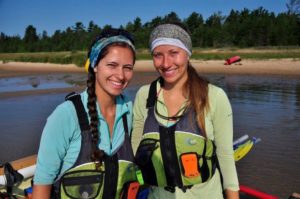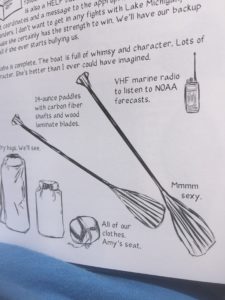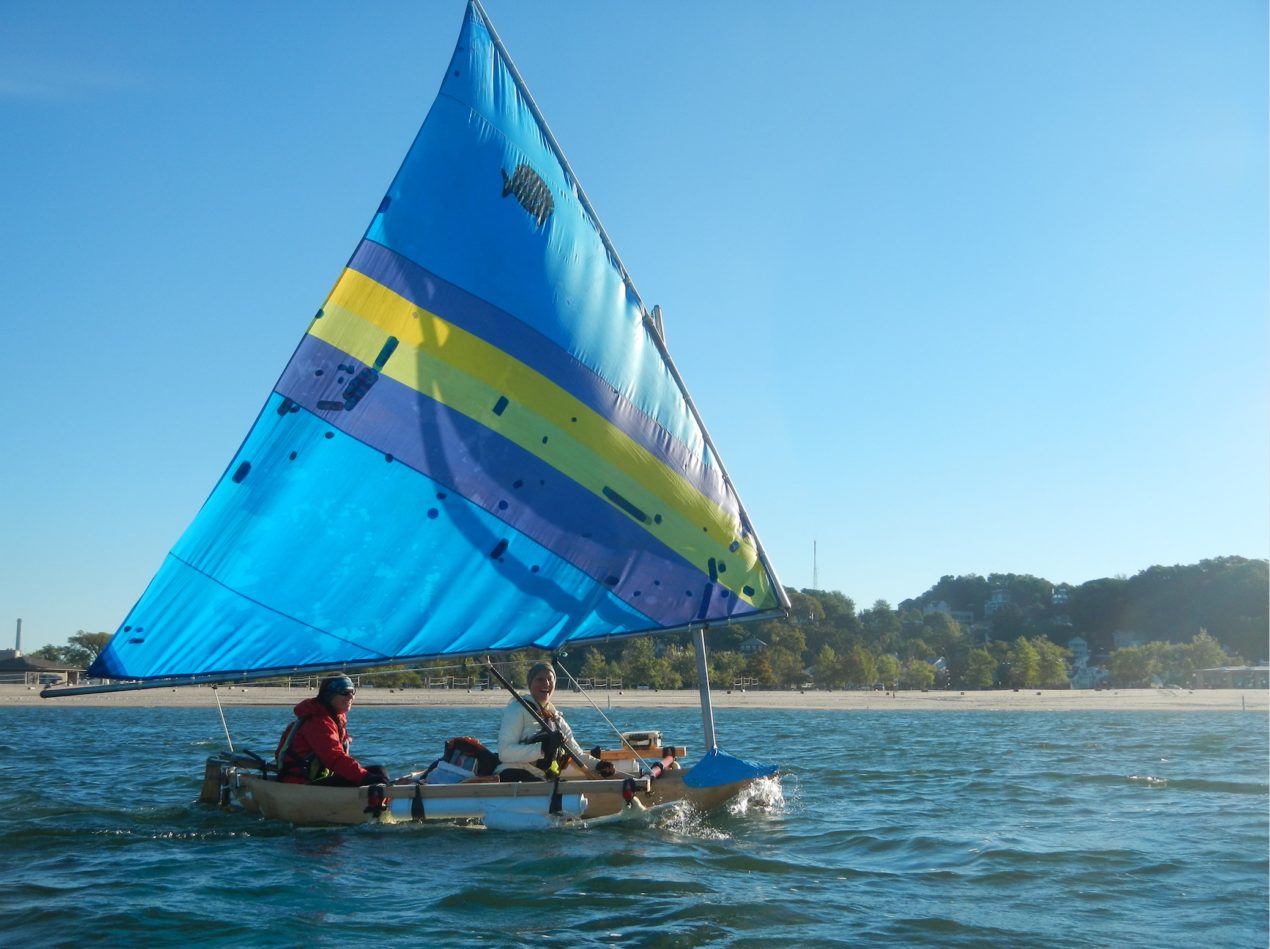“Lake Michigan in a Dugout Canoe: The Log” By Amy Lukas and Mary Catterlin
In 2008, when twenty-year-old Mary Catterlin realized she couldn’t afford a boat she decided to make one. After months of searching, she towed a massive log to her parents home in Beverly Shores, Indiana, and began chiseling away. “Logs float. Therefore, my tree-boat has to float,” Mary noted. Soon, her best friend Amy Lukas pinky promised to sail the finished handmade vessel around their beloved Lake Michigan together. With the help of their loved ones and the boating community, the duo pushed off three years later on their journey to circumnavigate the Great Lake.
Both women were avid journalers during their three-month trip and decided on Day 26 to write a book, “Lake Michigan in a Dugout: The Log.”
Trailer for The Log from Mary Catterlin on Vimeo.
The beginning
When the women told their families and friends about the trip idea, they were met with mixed emotions. Some people cheered and offered tips and resources. Others wondered when they’d realize their dream was too outlandish to succeed. People were wondering how they’d fit such a long adventure into their schedules while going to college and then starting “real life.” In the midst of boat building, Mary sent Amy an email that read,” I want you to punch me if we ever have to cut anything short because, ‘I have to get back to work.'”
They pushed on. Mary wanted to know the lake as never before. She grew up next to it but wanted to become even more familiar with its tempestuous ways and the interesting communities along the shoreline.
“It’s as though I’m trying to escape something just to come full circle. I’ve secretly been hoping that I will come back a better person. I’ve secretly been dreading that I will still be exactly the same,” she shared.
Amy, too, grew up alongside Lake Michigan and felt its pull. In the early stages of boat building she wasn’t sure the log would ever be seaworthy – would Mary’s grand idea become a reality or would the log end up back in the woods?
As Mary continued working on the vessel, the girls plans took shape. They crowdfunded, sought gear sponsorships and planned their daily mileage and supply pickups. During much of the planning phases, both women were going to school in separate states while dreaming of their summer adventure to come.
The boat
Makeba is an 11-foot wooden boat with a 10-foot mast and the sail from a Sunfish sailboat. Two eight-foot outriggers help keep the vessel afloat, providing stability and better dispersing the weight of Amy, Mary and their necessities.
In their book, Mary wrote that Makeba can be like that drunk friend you’re trying to escort home safely. The boat is oblivious to your goals and does what she wants but you love her and care for her all the same. The girls painstakingly addressed all of Makeba’s flaws while on the water, from patching holes with special formula boat epoxy to addressing cracking that occurred as the wood swelled when wet. Patching and otherwise dealing with Makeba issues (like that time they lost their rudder) was a recurring part of the Lake Michigan journey.
In 2012, after three years of on and off work, Makeba was finally ready for her first test run. Mary and Amy and a small gathering of family went to a local beach on the Great Lake and set the several hundred pound dugout canoe in the water. “Our adventure floats on!” wrote Mary.

In the elements: 93 days
Lake Michigan is tempestuous. She is constantly changing with no notice, a fact that proved true throughout the girls’ adventure. “Lake Michigan is neither for us nor against us,” Mary wrote in the Log Book.
They would frequently take off or put on layers of clothing to address the chilly mornings, hot afternoon sun and colder evenings. They trip lasted three months, and by their final paddle strokes in September, fall had set in, bringing with it higher winds and lower temperatures.
Near the end of the journey, around Green Bay Wisconsin, Amy wrote, “There is a time to move and a time to be still.” Both women learned patience as nearly a third of their trip was spent on weather days, docked out of harms way or pulled up onto the shore waiting for favorable winds and calmer water.
On their very first day on the lake, just a few miles from home, Amy and Mary came across a storm. After pulling Makeba onto the shore and running for safety, they made new friends with a couple who invited them in for pizza. The women had been on the water a few hours and were already getting a glimpse into their next three months of unexpected hospitality during the most trying times. Amy wrote, “We’ve been meeting people I feel like I should have known my whole life.”
The duo picked up food along the journey at post offices where they mailed themselves packages full of dried goods. They also stopped at grocery stores to grab fresh goods and often get down on fresh deli goods while they could. “We get too excited about food,” the women wrote. At a beachside BBQ, a peach made its way into Makeba where it was coveted until the last of its sweet juices were licked off chins and fingers rinsed of sticky goodness mid-paddle.
The famous trail magic along long thru-hiking areas is alive and well in the Midwest along Lake Michigan. When the sailors would stop to make camp at a marina or a private beach, they’d often be invited in to enjoy cold drinks, warm beds and showers. Everywhere they went word quickly spread that two young women were paddling a handmade boat around the lake. That led to many chance encounters with local journalists and unexpected kindness at every corner.

Lake Michigan in a Dugout: The Log
The book is written as if Amy and Mary’s trip journals were superimposed next to each other. Readers see both girls’ personalities and how they experienced events differently. Amy often writes longer, more in-depth entries with details that paint a picture of their day and the people they meet. Mary admits she’s less social, but both agree, that the incredible experiences they had with strangers along the way were a huge part of the trip. A good portion of Mary and Amy’s journals was dedicated to chronicling the amazing people they met, places they stayed and stories they heard from new friends. Mary’s reluctance to spread the word about their journey soon subsided as they continued having amazing meetups with complete strangers and friends of friends. Reading The Log may make you want to try a journey of your own, not just to have an awesome notch on your adventure belt but to experience heartwarming openness and genuine acts of kindness like the ones these women came upon along the shores of Lake Michigan.
The future
When the women made it back to their home beach, just past the exact GPS points where they left from in July, they were thrilled. In 93 days they had joined a small club of tenacious individuals who circumnavigated Lake Michigan by human power. But that wasn’t their whole goal. Amy and Mary came to know so much about their beloved Lake, from becoming best friends with the National Oceanic and Atmospheric Administration weather radio (NOAA) to how to learn to trust strangers offering food, rides and places to stay. They gained patience, technical know-how and boating skills that will last long after the smell of freshwater is rinsed from their hair.
The Lake Michigan in a Dugout women plan to recreate this trip on every Great Lake, but this time with other transportation like kayaks, SUPS or by “any means necessary.” Keep an eye out on their website and social media to see when they plan to set out next.
You can follow Mary Catterlin and Amy Lukas:
Web: https://lakemichiganinadugout.blogspot.com/
Instagram: Mary – https://www.instagram.com/mcatterlin/
Amy – https://www.instagram.com/amy_lu3/

